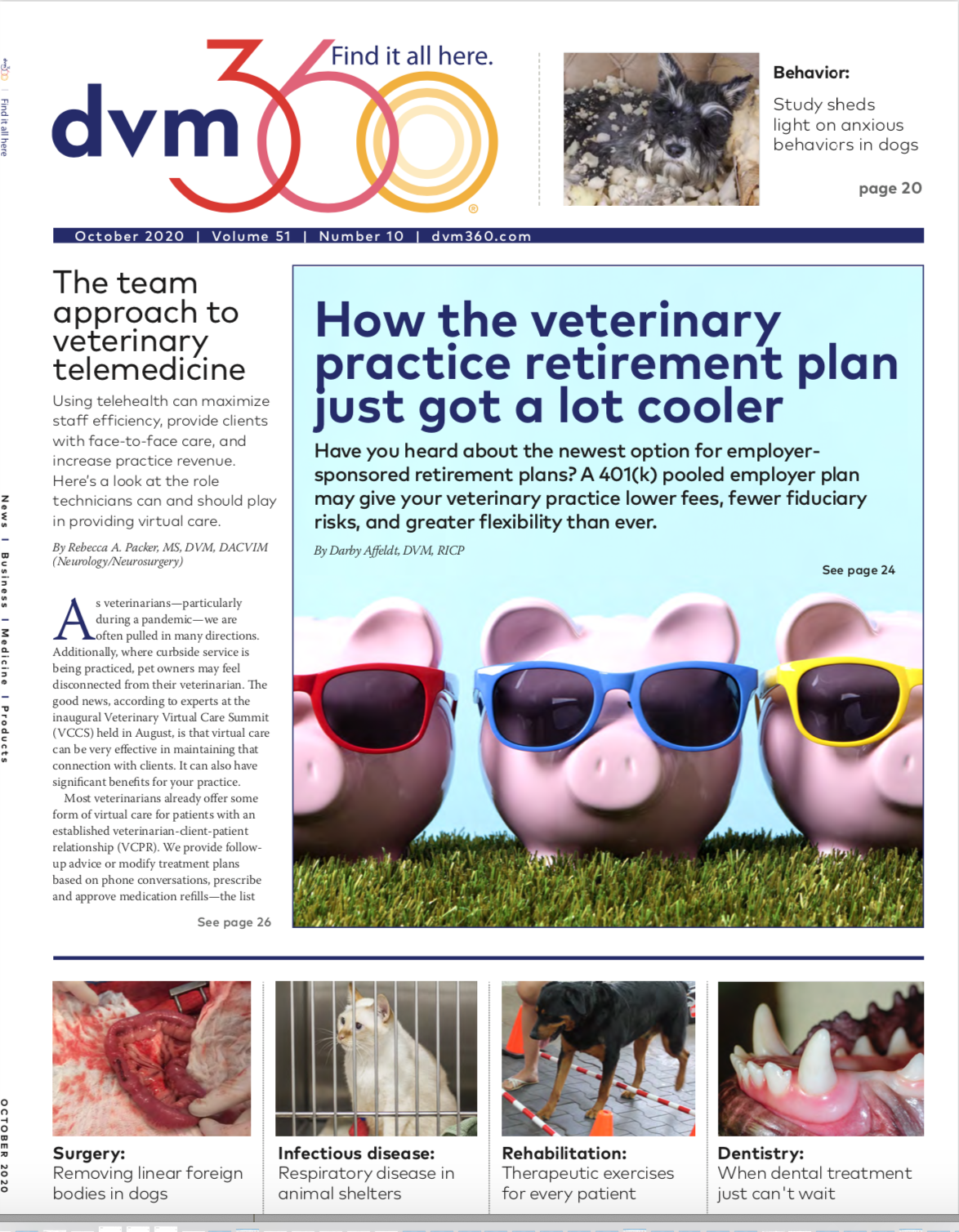How the veterinary practice retirement plan just got a lot cooler
Have you heard about the newest option for employer-sponsored retirement plans? A 401(k) pooled employer may give your veterinary practice lower fees, fewer fiduciary risks, and greater flexibility than ever.
Sandra / stock.adobe.com

Pandemic or not, today’s veterinary job market remains tight, with many practice owners fighting to hire and keep talented associates, veterinary technicians, and other team members. Retirement plans, although not usually at the top of employee wish lists, are an important way to attract and hold on to staff. Now, thanks to a move made by Congress in late 2019, it is easier than ever to offer a 401(k) retirement plan.
Practice owners, too, should consider looking for ways to save and invest money outside the eventual sale of their hospital. Few of us would consider putting all our retirement savings into a single stock, but many practice owners put all their eggs in 1 basket: their practice value. When it comes to retirement income planning, it’s wise to diversify and build multiple “buckets” of assets, some taxable, some tax-deferred, some Roth (after-tax contributions).
Retirement plan basics
Before getting into the nitty-gritty of a really exciting new retirement plan option available to veterinary professionals, covering the basics of currently available plans might be useful.
Many veterinary practices start out with the Savings Incentive Match Plan for Employees (SIMPLE) IRA, which allows a higher annual contribution than the traditional or Roth IRA’s current maximum contribution limits ($6000/year or $7000 for those over age 50). In 2020, for example, the SIMPLE IRA allows annual contributions of $13,500, plus another $3000 for a catch-up contribution for those over age 50. The SIMPLE IRA also offers tax benefits today, because contributions go in pre-tax.
Fortunately, the rules for SIMPLE IRAs are relatively, well, simple: An employer agrees that if a qualifying employee (including the employer) contributes pre-tax income, the employer will match that contribution, up to certain limits. There are 2 options for that match, either 2% “non-elective” or, more often used, 3%. With the latter option, if an employee contributes 1% of their income, the match from the employer is 1%. If an employee contributes 4%, the most the employer matches is 3%. And, of course, if the employee puts in nothing, the employer matches nothing.
One common mistake, however, is when practice owners implement a SIMPLE IRA and “set it and forget it.” There may come a time when a SIMPLE IRA won’t cut it. That’s where a 401(k) comes in. Why? The 401(k) is more flexible, and perhaps the practice owner and/or associate doctors have maxed out their SIMPLE IRA contributions and need to be saving more, which is possible in a 401(k) plan. It’s common for a newly hired financial professional to discover that it may have made sense for a veterinary practice to have switched to a 401(k) years ago, and that delay carries financial repercussions in outgrowing those annual contributions, missing tax strategies, and missing out on some important flexibility for team members.
The benefits of a 401(k) can come with a cost: Managing a 401(k) can be more complex and means practices may need to pay a third-party administrator to help administer the plan, file the plan annual report (called a Form 5500), etc. Practice owners sometimes worry that those increased administrative expenses are exorbitant (or maybe not, considering the tax savings). A financial professional should do the heavy lifting and run all those projections for you. Many practice owners end up learning that the 401(k) is not as bad as they’d imagined.
One of the biggest benefits of 401(k) plans, of course, is the higher annual contribution mentioned earlier—in 2020, employees can contribute $19,500 per year, plus another $6,500 for those over 50. These plans are also more flexible than the SIMPLE IRA and can even include a way to offer both pre- and post-tax retirement savings options. Other possible options in 401(k) plans include:
- Employer matching
- Requiring employee longevity before fully vesting
- The ability for employees to take out loans against their own balances
Practices can even explore profit-sharing options to save more for themselves pre-tax while sharing with hard-working employees.
Fiduciary what now?
Sounds perfect, right? Maybe not. Perhaps the biggest downside of 401(k) plans isn’t actually the cost but rather the fiduciary duties a practice takes on when it starts a plan. Because the practice owner has authority over the plan design, investment options, and expenses, they must meet important and strict responsibilities. Over the past decade, several high-profile 401(k) fee lawsuits have been levied against employers failing to meet their fiduciary duties. According to Ryan N. Parsons, JD, senior counsel for Foley & Lardner, LLP, fiduciary litigation is on the rise.1
Who wants this risk or, alternatively, who wants to attend fiduciary training, continually negotiate plan fees, and document everything on top of all the other and more familiar hats the practice owner already wears? The Department of Labor could fine a practice owner heavily if these duties are not met, yet the duties are often ignored, poorly explained, or overlooked by owners or financial professionals serving individual plans. Just 1 disgruntled employee looking for a payday could mean serious problems for practices with a 401(k).
A new and exciting retirement plan option
The solution to this fiduciary and higher-fee conundrum is a little-known strategy bundled in a fabulous holiday gift in December 2019. The Setting Every Community Up for Retirement Enhancement (SECURE) Act, which became law late last year, includes a provision for a 401(k) pooled employer plan (PEP), with the first plans scheduled to start January 1, 2021. A PEP allows a group of unrelated businesses (say, veterinary practices) and even the self-employed (say, relief doctors) to pool their 401(k) assets, and a pooled plan provider (PPP) provides many of the fiduciary duties for the entire plan. Better still, with the increased assets of a 401(k) PEP, individual practices can now achieve the same economies of scale that very large plans can, potentially lowering fees for all participating employees.
A PEP doesn’t require that each participating business use a generic plan either; practices design their own unique plan. Even existing 401(k) plans can be rolled easily into a PEP. Assets are not in the same investments; they’re pooled at 1 Recordkeeper. Administrative fees to the practice will likely drop as well.
Because the legislation is so new, as of September 2020, possibly only 1 medical group in the United States has announced the adoption of a PEP. The PSIvet PEP starts January 1, 2021.2 (Full disclosure: I was working on my financial professional continuing education by studying all of the changes with the SECURE Act—which affects many areas of financial services—and noticed something called the PEP. Curiosity drove me to investigate what it was, and when I approached PSIvet with the idea they were immediately excited. I am the new PEP’s representative.)
Time may be of the essence
Timing is critical because IRS regulations dictate that a practice cannot contribute to both a SIMPLE IRA and a 401(k) in the same calendar year. Now is a good time to ask your financial professional if the PEP is a good fit for your practice in 2021. If a switch is warranted, a 60-day notice that the SIMPLE plan is terminating and a 401(k) plan is starting up is required for all employees. The PEP could be a good fit if 2020 has been a profitable year and your hospital doesn’t have a retirement plan or your SIMPLE IRA has become too small.
Talk to your financial professional
Thinking about retirement plans in an emotional election year and during a global pandemic might make you nervous. It’s understandable if you just want to stay the course, put your head down, and get back to the exam room. But hiding from financial decisions has repercussions as well, and evaluating retirement plan options might be one of the most positive decisions you make this year. Talk to your financial professional and look into it. You might just develop a sense of security knowing that you’ve evaluated all the options for yourself and for your current and future employees.
Darby Affeldt, DVM, RICP, is a financial advisor and associate partner with North Star Resource Group. Her own veterinary background inspires her to work with veterinary professionals, offering comprehensive financial planning, asset management, and insurance strategies to help her clients to reach their personal and practice planning goals.
North Star Consultants, Inc. - Insurance Products and Services. CRI Securities, LLC - Securities and Investments. Securian Financial Services, Inc. - Variable Products and Securities. Securities and investment advisory services offered through CRI Securities, LLC and Securian Financial Services, Inc. Members FINRA/SIPC. CRI Securities, LLC is affiliated with Securian Financial Services, Inc. and North Star Resource Group. North Star Consultants, Inc. is doing business as North Star Resource Group and is independently owned and operated. 2701 University Ave SE, Minneapolis, MN 55414. 3255517/DOFU 9-2020. Darby is a registered representative and investment advisor representative of CRI Securities, LLC and Securian Financial Services, Inc. Financial professionals do not provide tax or legal advice and this should not be considered as such. Please consult a tax or legal professional for advice regarding your specific situation.
References
- Parsons RN. 401(k) Fiduciary litigation on the rise – take these steps now to avoid liability later. Foley & Lardner LLP.Published August 17, 2020. AccessedSeptember 20, 2020. https://www.foley.com/en/insights/publications/2020/08/401k-fiduciary-litigation-on-the-rise
- The Platinum 401k, Inc. announces the formation of the PSIvet members pooled employer plan. Press release. July 28, 2020. Accessed September 20, 2020. https://benefitslink.com/cgi-bin/pr/index.cgi?rm=press_release&id=53488
